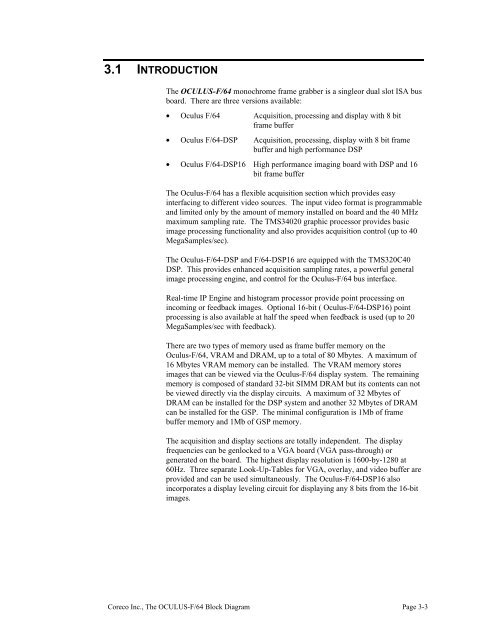THE OCULUS-F/64 FRAME GRABBER User's Manual
THE OCULUS-F/64 FRAME GRABBER User's Manual
THE OCULUS-F/64 FRAME GRABBER User's Manual
You also want an ePaper? Increase the reach of your titles
YUMPU automatically turns print PDFs into web optimized ePapers that Google loves.
3.1 INTRODUCTION<br />
The <strong>OCULUS</strong>-F/<strong>64</strong> monochrome frame grabber is a singleor dual slot ISA bus<br />
board. There are three versions available:<br />
• Oculus F/<strong>64</strong> Acquisition, processing and display with 8 bit<br />
frame buffer<br />
• Oculus F/<strong>64</strong>-DSP Acquisition, processing, display with 8 bit frame<br />
buffer and high performance DSP<br />
• Oculus F/<strong>64</strong>-DSP16 High performance imaging board with DSP and 16<br />
bit frame buffer<br />
The Oculus-F/<strong>64</strong> has a flexible acquisition section which provides easy<br />
interfacing to different video sources. The input video format is programmable<br />
and limited only by the amount of memory installed on board and the 40 MHz<br />
maximum sampling rate. The TMS34020 graphic processor provides basic<br />
image processing functionality and also provides acquisition control (up to 40<br />
MegaSamples/sec).<br />
The Oculus-F/<strong>64</strong>-DSP and F/<strong>64</strong>-DSP16 are equipped with the TMS320C40<br />
DSP. This provides enhanced acquisition sampling rates, a powerful general<br />
image processing engine, and control for the Oculus-F/<strong>64</strong> bus interface.<br />
Real-time IP Engine and histogram processor provide point processing on<br />
incoming or feedback images. Optional 16-bit ( Oculus-F/<strong>64</strong>-DSP16) point<br />
processing is also available at half the speed when feedback is used (up to 20<br />
MegaSamples/sec with feedback).<br />
There are two types of memory used as frame buffer memory on the<br />
Oculus-F/<strong>64</strong>, VRAM and DRAM, up to a total of 80 Mbytes. A maximum of<br />
16 Mbytes VRAM memory can be installed. The VRAM memory stores<br />
images that can be viewed via the Oculus-F/<strong>64</strong> display system. The remaining<br />
memory is composed of standard 32-bit SIMM DRAM but its contents can not<br />
be viewed directly via the display circuits. A maximum of 32 Mbytes of<br />
DRAM can be installed for the DSP system and another 32 Mbytes of DRAM<br />
can be installed for the GSP. The minimal configuration is 1Mb of frame<br />
buffer memory and 1Mb of GSP memory.<br />
The acquisition and display sections are totally independent. The display<br />
frequencies can be genlocked to a VGA board (VGA pass-through) or<br />
generated on the board. The highest display resolution is 1600-by-1280 at<br />
60Hz. Three separate Look-Up-Tables for VGA, overlay, and video buffer are<br />
provided and can be used simultaneously. The Oculus-F/<strong>64</strong>-DSP16 also<br />
incorporates a display leveling circuit for displaying any 8 bits from the 16-bit<br />
images.<br />
Coreco Inc., The <strong>OCULUS</strong>-F/<strong>64</strong> Block Diagram Page 3-3


